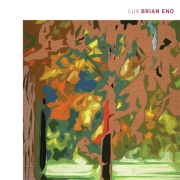Lux, the surrounding press and publicity tells us, finds Brian Eno returning to the themes and sounds explored on his original Ambient series in the late 70s and early 80s. This shorthand promises a slow, spare, instrumental album, but also serves as a coded “stunning return to form": here is late work from a living legend that’s up there with his early classics. The truth is less slick and more colourful, but for once the eyebrow-raising pitch isn’t totally disingenuous. Lux is a strong Eno album, and a real development in his ambient line.
To hear why, it’s useful to remember what those previous excursions actually sounded like. They were so varied – in style and structure, in aim and efficacy – that the ‘ambient’ brand alone doesn’t tell you a great deal. The tantalising blarney in Eno’s sleevenotes for Music for Airports, his manifesto for ambient music, could easily have been written for a record he would never make. The four longish pieces which make up that album are just too arresting, too gorgeous to be “as ignorable as [they are] interesting". For a professed non-musician, Eno has never been very good at disappearing. His taste for beauty suffused everything he worked on back then, often transmuting it into that none-less-ignorable state, the sublime. The lengthy loops of dulcimer and zither on _Day of Radiance_, like the discreet moments of piano-led grace that add up to Plateaux of Mirror, lift you high above the clouds. As far removed as they are from each other, neither would function as Eno’s mooted “tint" for earthbound environments. Theory’s loss was music’s gain.
Other outings had implied narratives, however oblique, to hold the listener’s attention. On _Apollo…_ you know man is going to the Moon, but even the fragments written, used in or intended for films, compiled in the Music For Films series, prompt you to imagine the absent celluloid. Meanwhile, when Eno went off-road the drama actually grew. On Land drops you into unmapped territories, drifts through shadows and peripheries; your mind can’t help but reach for bearings as the album’s droney, Lynchian consistency engulfs you.
Where Eno’s ambient work begins and ends – what to pay attention to or ignore here – is a suitably blurred issue. But a turning point of sorts came in 1985’s Thursday Afternoon, the pleasantly aimless hour composed to accompany his (NSFW) ‘video paintings’. The audio was the first of Eno’s many installation/gallery soundtracks to get a proper album release. Its spacious, simple piano lines produce a lovely tint for a room, having just enough motion and melody to draw you in once in a while without keeping you locked; although you probably wouldn’t go the distance in one sitting. But the next album in what you might call his Muzak for Art Galleries series was a stinker. 1993’s Neroli, the product of his admirably flagrant but mercifully brief aromatherapy phase, was so subdued and repetitious that it was difficult to imagine what situation might be enhanced by it or how.
So you could be forgiven a little apprehension when approaching Lux, the third major instalment in the series I’ve just invented. It was developed from pieces Eno designed to be played in the baroque Great Gallery of the Palace of Venaria in Turin. In that context this music could provide a tender corrective, leading you to linger without feeling cowed by the imposing, prescriptive décor. On its own, Lux sounds like a sustained composition directed by whim and wonder – the first we’ve heard from him since his imperial phase. A piano is the star of the piece, as it was in Thursday Afternoon and ‘1/1’ from …Airports. But the sound palette could only reasonably exist today and, unlike those pieces, Lux isn’t essentially one long loop. The opening few minutes sound like random, pleasant plonking, but from there on in it takes on stronger form. Numerous stages bleed into each other almost imperceptibly over the course of its 75 minutes. (Continuity hasn’t been Eno’s strong suit on previous albums; each track tends to sound like a separate project.) Stay for the duration and you’ll feel involved throughout. Leave the room, and when you return things will have moved on but you won’t feel as if you’ve missed out.
Descriptions of vague, minimal instrumental music only go so far, but what impresses the most about Lux is the elegant dance between attack and decay running through it. Piano notes ring out and fade slowly in subtly coloured space; digital counterpoints build in response, creating a weightless grace. Occasionally, other tones weave through like sky trails. Small gestures naturally take on greater weight in this ambience. Around the 37 minute mark you get a jolt when the higher piano notes become slightly more plangent; bass notes add a whole new dimension. At 57 minutes only bare bones piano tones remain; five minutes later digital textures seep in again; single piano notes now ring in the distance, stretching the space. When I took on this review I was all set to take the old gobshite to task for his latterday brand management manouevres. But Lux is a surprisingly rich experience that’s difficult to fault. It’s not the most startling record Eno’s ever made, but it probably is his most successful ambient work.


